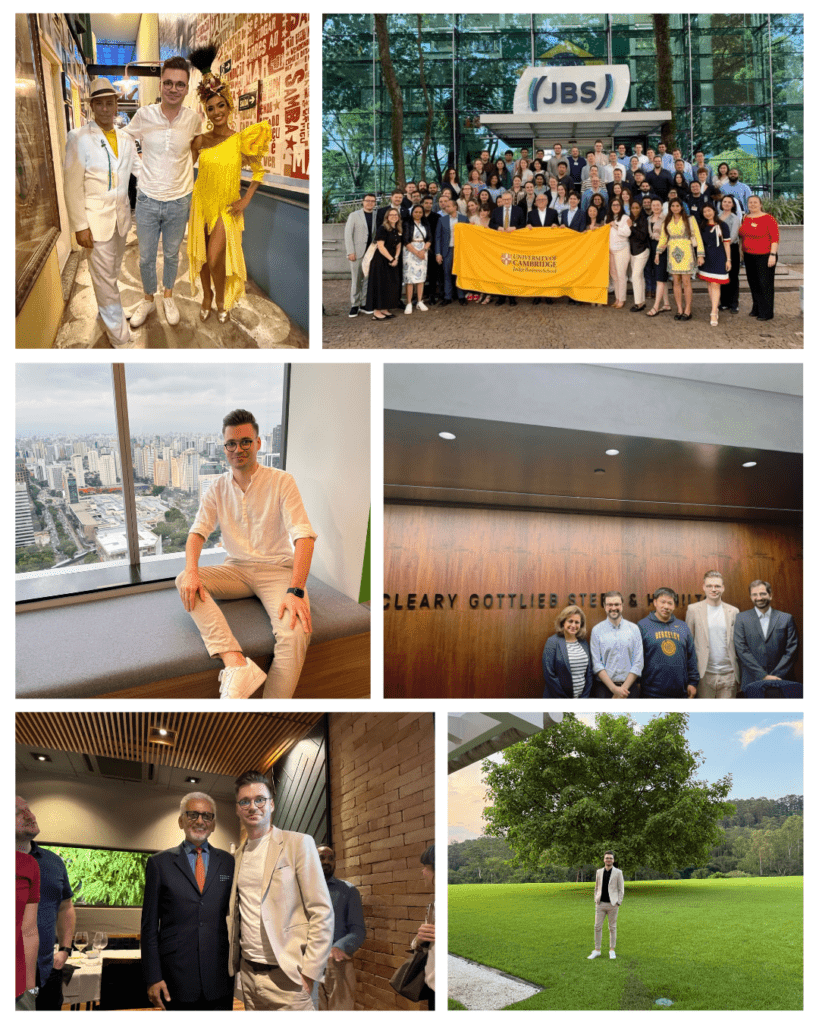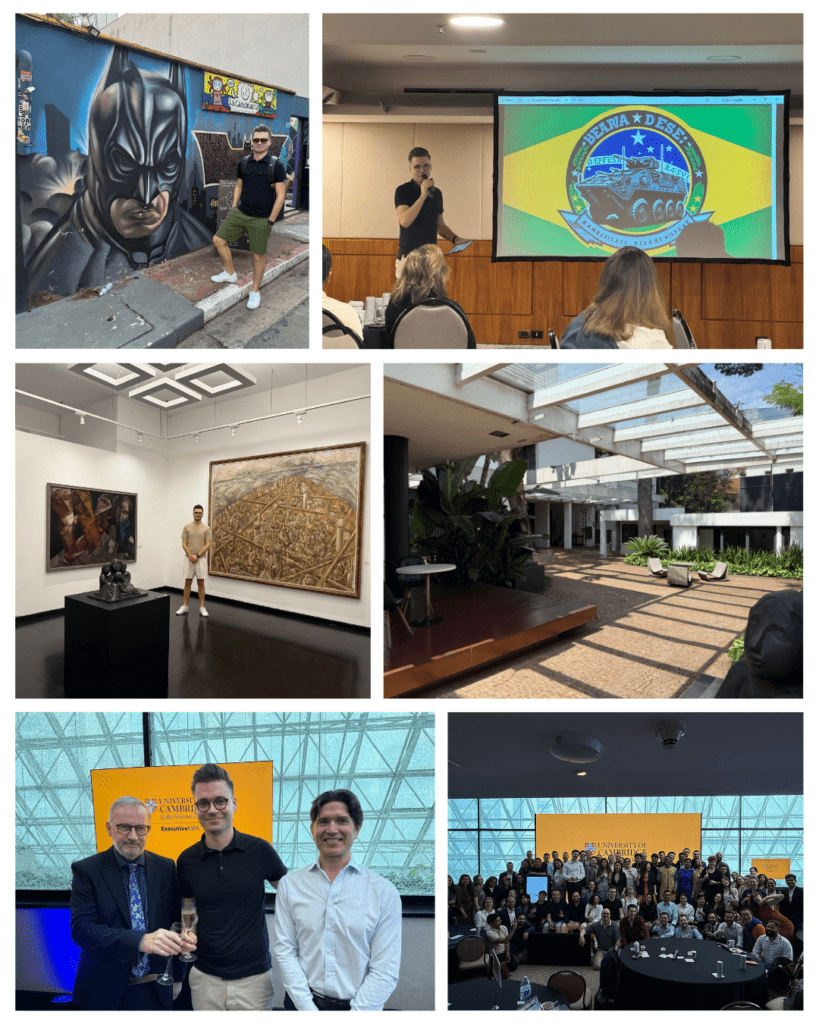The International Business Study Trip (IBST) is one of the core courses on our Executive MBA programmes. Taking place over a week of lectures and site visits, with the location carefully selected based on current economic trends around the world, it represents an excellent opportunity for students to be exposed to different cultures, industry information, and acumen from observing leaders formulating internationalisation strategies; providing the tools and perspectives necessary to navigate cross-cultural business landscapes effectively.
After Jade Weiner penned a blog post providing a holistic overview of the module from the group’s perspective last week, Karolis Jonuska (EMBA 2024) takes us back to São Paulo recounting his personal experience, discoveries, and take-aways from a stimulating and inspiring trip to Brazil.

A Blog post by Karolis Jonuska (EMBA 2024)
Classrooms in Skyscrapers
It’s midweek in São Paulo. I’m standing inside the glass walls of a skyscraper, discussing sustainability goals with Brazilian company executives. Outside the window: helicopters landing on rooftops—São Paulo leads the world in helicopters per capita, with the busiest rotorcraft traffic and its own dedicated air traffic control. But just below, in the roundabouts and supermarket corners, I see tents and makeshift homes. Homelessness lives in the shadows of privilege. This is Brazil—rich in contradiction, bursting with creativity. A place that doesn’t just show you contrasts—it demands you learn from them. And I did.
From Michaelmas to 30°C Samba
Back in Michaelmas term, I was huddled over my notes in Cambridge, one hand holding a pen, the other a cup of tea. I couldn’t have imagined that four months later I’d be dancing samba in 30°C heat with classmates in the financial capital of South America. Brazil was full of surprises. But more importantly, it was full of lessons—in resilience, leadership, innovation, and culture.
Frameworks and Reality Collide
Each year, the Cambridge EMBA cohort travels to a chosen country to explore business in a global context. São Paulo, the 4th largest city in the world, was selected for its economic significance—home to LATAM’s major corporations, fintech start-ups, and social enterprises alike. The goal wasn’t to study Brazil in isolation. Rather, it was to apply frameworks from international business, macroeconomics, and institutional theory—then challenge them against reality. And challenge they did.
Our academic sessions were led by Professor Chris Marquis, who unpacked institutional and cultural frameworks through a sustainability lens, and Professor Michael Kitson, who focused on macroeconomic challenges, innovation systems, and business resilience. The theory came alive in real-world encounters—especially during evening events with standout business leaders.
Lessons in Humanity
One such leader was Flavia Bittencourt, CEO of Adidas Latin America. Under her leadership, Adidas has grown across a continent defined by wildly different markets and deep economic volatility. She shared insights on how to build brand loyalty and lead through complexity, but what stayed with me most was her personal story of perseverance—from humble beginnings to executive leadership. Her courage and creativity reminded me that innovation in unpredictable environments isn’t optional—it’s survival.
Then came Jerry O’Callaghan, Chairman of JBS, the world’s largest meat processing company. He spoke with a calm authenticity and deep understanding of both global trade and local communities. Jerry shared how JBS embraces its role as a community-driven business despite its global scale, emphasizing how relationships and integrity still underpin success in emerging markets.
Finally, Gaetano Crupi, former CEO of Bristol-Myers Squibb in Brazil, offered a completely different tone—quieter, more introspective. He talked about the legacy we leave behind, and how values-based leadership has shaped his career in the pharmaceutical industry. He urged us to slow down, to reflect, and to listen—especially in high-pressure roles. There were many more inspiring speakers throughout the week, but these three made the strongest impact on me personally.
Unexpected Encounters with Home
Outside the formal program, I found moments of unexpected connection. On the way to a university art gallery, I found myself in a conversation with a local guide. When he heard I was from Lithuania, he lit up and led me straight to a painting by Lasar Segall—a Lithuanian-born Jewish modernist who emigrated to Brazil and became one of its most significant artists. Segall’s work speaks of migration, identity, and human suffering. His legacy bridges continents and stories.
I later visited the Lasar Segall Museum—his former home in São Paulo—where I was moved by his paintings, especially The Emigrant Ship, which captures the dislocation and hope of those who cross oceans. There, by a stroke of coincidence, I met a Lithuanian-Brazilian couple. Though they no longer spoke the language, their roots and stories were an unexpected reminder of how small and interconnected the world can feel.
Art that floats in air
São Paulo’s cultural landscape surprised me even more at MASP (Museu de Arte de São Paulo), where a Renoir exhibit had just opened. The museum’s architecture is striking—paintings mounted on transparent glass panels that seem to float mid-air. The space itself becomes part of the art-viewing experience. I could’ve stayed there for hours. The concrete skeleton of the building stands in contrast to the vibrancy of its art—Brazilian modernism next to European impressionism. A metaphor, perhaps, for Brazil itself.
When Brazil Met Lithuania
Our final assignment was to analyse how a Brazilian company might export to a target market. By fate or design, our group received Lithuania. At first, I thought the challenge would be finding any common ground. But the more we researched, the more connections we found. Both countries are navigating transitions—Brazil as an emerging economy balancing scale and inequality; Lithuania as a post-Soviet nation transforming into an EU innovation hub.
We ended up proposing a defence-tech export model with local assembly in Lithuania—a business plan rooted in political realism and strategic ambition. But for me, the real insight was how two seemingly distant countries could mirror each other in resilience, creativity, and complexity.
What I Didn’t Expect to Learn
I began this EMBA journey looking to reinvent myself—to develop a more authentic leadership mindset, sharpen my thinking, and surround myself with excellence. I got all that. But I also got something more: humility. Business isn’t just models and margins. It’s people, place, and purpose.
As our professor Khaled Soufani said in our first week: this is the hardest programme across Cambridge University and Judge Business School. And it shows.
Why Brazil was the right trip at the right time
The Brazil trip reminded me of what makes this EMBA experience unique: the brilliant, diverse cohort—73 executives from across the globe who teach me something new every day; the faculty and staff who push us to go further; and the culture of Cambridge, where thinking differently isn’t just allowed—it’s expected.
Brazil didn’t just teach me about business. It taught me about rhythm. About leading in uncertainty. About daring to connect across distance, culture, and complexity. It taught me that growth doesn’t always feel like acceleration—sometimes it feels like stillness, like perspective, like dancing samba when you least expect it.



Leave a Reply